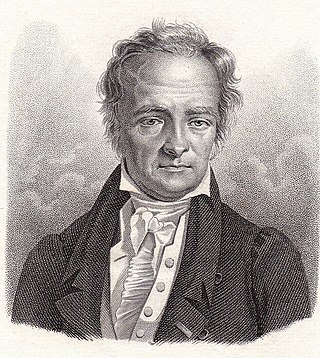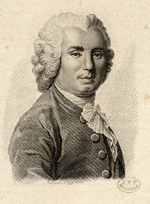Related Research Articles

Antoine-Laurent de Lavoisier, also Antoine Lavoisier after the French Revolution, was a French nobleman and chemist who was central to the 18th-century chemical revolution and who had a large influence on both the history of chemistry and the history of biology.

Pierre Samuel du Pont de Nemours was a French-American writer, economist, publisher and government official. During the French Revolution, he, his two sons and their families immigrated to the United States.

Antoine François Fourcroy was a French chemist and a contemporary of Antoine Lavoisier. Fourcroy collaborated with Lavoisier, Guyton de Morveau, and Claude Berthollet on the Méthode de nomenclature chimique, a work that helped standardize chemical nomenclature.
The year 1787 in science and technology involved some significant events.
The year 1826 in science and technology involved some significant events, listed below.
The year 1771 in science and technology involved some significant events.
The year 1776 in science and technology involved some significant events.
The year 1728 in science and technology involved some significant events.
The year 1774 in science and technology involved some significant events.
The year 1760 in science and technology involved some significant events.

Louis Augustin Guillaume Bosc was a French botanist, invertebrate zoologist, and entomologist.

Samuel Auguste André David Tissot was a notable 18th-century Swiss physician.

Antoine Louis was an 18th-century French surgeon and physiologist.
Raoul Bensaude was a French physician born in the Azores. He became a famous gastroenterologist that pioneered proctology in France. With Pierre-Emile Launois (1856-1914), he provided a detailed description of multiple symmetrical lipomatosis, also referred to as "Launois-Bensaude syndrome".
The Commission des Sciences et des Arts was a French scientific and artistic institute. Established on 16 March 1798, it consisted of 167 members, of which all but 16 joined Napoleon Bonaparte's conquest of Egypt and produced the Description de l'Égypte. More than half were engineers and technicians, including 21 mathematicians, 3 astronomers, 17 civil engineers, 13 naturalists and mining engineers, geographers, 3 gunpowder engineers, 4 architects, 8 artists, 10 mechanical artists, 1 sculptor, 15 interpreters, 10 men of letters, 22 printers in Latin, Greek and Arabic characters. Bonaparte organised his scientific 'corps' like an army, dividing its members into 5 categories and assigning to each member a military rank and a defined military role beyond his scientific function.
Jean-Baptiste-Michel Bucquet was a French chemist, member of the French Royal Academy of Sciences, physician and public teacher.

Théophile de Bordeu was a French physician.

Claudine Picardet was a chemist, mineralogist, meteorologist and scientific translator. Among the French chemists of the late eighteenth century she stands out for her extensive translations of scientific literature from Swedish, English, German and Italian to French. She translated three books and thousands of pages of scientific papers, which were published as well as circulated in manuscript form. She hosted renowned scientific and literary salons in Dijon and Paris, and was an active participant in the collection of meteorological data. She helped to establish Dijon and Paris as scientific centers, substantially contributing to the spread of scientific knowledge during a critical period in the chemical revolution.

Louis Lépecq de La Clôture was a French surgeon and epidemiologist. His work consisted mainly of a 15-year observation of the relations between climate, geography and pathologies in Normandy.
Pierre Amable Jean-Baptiste Trannoy is a French physician, hygienist and botanist.
References
- ↑ "Lavoisier, Antoine." Encyclopædia Britannica. 2007. Encyclopædia Britannica Online. 24 July 2007 .
- ↑ Weisstein, Eric W. (1996). "Lavoisier, Antoine (1743–1794)". Eric Weisstein's World of Scientific Biography. Wolfram Research Products. Retrieved 2007-02-23.
- ↑ Collingridge, Vanessa (2003). Captain Cook: The Life, Death and Legacy of History's Greatest Explorer. London: Ebury Press. ISBN 0-09-188898-0.
- ↑ Cook, Andrew S. (2004). "Rennell, James (1742–1830)" . Oxford Dictionary of National Biography (online ed.). Oxford University Press. doi:10.1093/ref:odnb/23369 . Retrieved 2011-04-05.(Subscription or UK public library membership required.)
- ↑ Karbowski, K. (April 1986). "Samuel Auguste Tissot: his research on migraine". Journal of Neurology . 233 (2): 123–125. doi:10.1007/BF00313859. ISSN 0340-5354. PMID 3517238. S2CID 24691943.
- ↑ Pearce, J.M.S. (September 2000). "Samuel-Auguste Tissot (1728-1797) and migraine". Cephalalgia . Norway. 20 (7): 668–70. doi:10.1111/j.1468-2982.2000.00100.x. ISSN 0333-1024. PMID 11128826. S2CID 36466035.
- ↑ Lépecq de La Cloture, Louis (1778). Collection d'observations sur les maladies et constitutions épidémiques: ouvrage qui expose une suite de quinze années d'observations, & dans lequel les épidémies, les constitutions régnantes & intercurrentes, sont liées (partie I) (in French). Rouen: Imprimerie privilégiée. Retrieved 28 February 2021.
- ↑ Lépecq de La Cloture, Louis (1778). Collection d'observations sur les maladies et constitutions épidémiques: ouvrage qui expose une suite de quinze années d'observations, & dans lequel les épidémies, les constitutions régnantes & intercurrentes, sont liées (partie II,III et IV) (in French). Rouen: Imprimerie privilégiée. Retrieved 28 February 2021.
- ↑ Williams, Hywel (2005). Cassell's Chronology of World History . London: Weidenfeld & Nicolson. pp. 331–332. ISBN 0-304-35730-8.
- ↑ Troyano, Leonardo Fernández (2003). Bridge Engineering: a Global Perspective. London: Thomas Telford Publishing. pp. 158–9. ISBN 0-7277-3215-3 . Retrieved 2011-08-16.
- ↑ Tuxen, S. L. (1967). "The entomologist J. C. Fabricius". Annual Review of Entomology . 12: 5. doi:10.1146/annurev.en.12.010167.000245.
one of the most important books in entomology of all times
- ↑ "Copley Medal | British scientific award". Encyclopedia Britannica. Retrieved 21 July 2020.